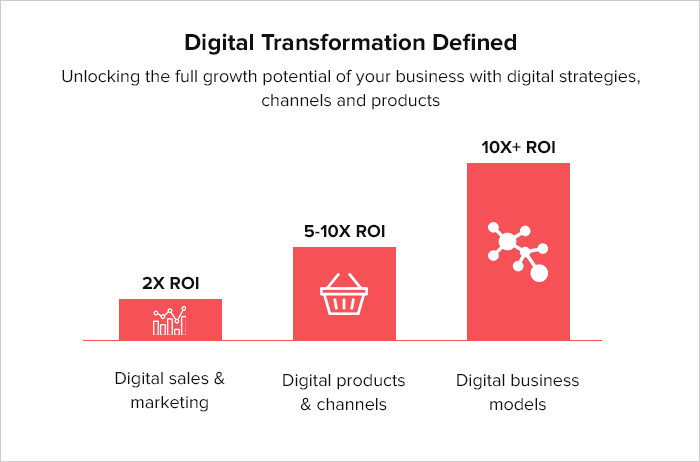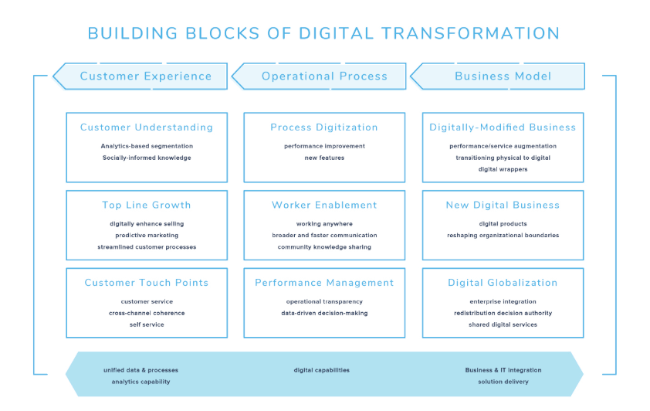Today’s topic describes the ongoing process for every business to consider changing its working habits. If you want to meet the latest market requirements in this digital age it is crucial to evolve. It’s about every improvement that aims at re-imagining a company’s work environment to make it more fluid. Most importantly, better interactions with your customers are part of this deep systemic change we call digital transformation. That’s what we will help you understand today.
Above all else, let us start with a funny fact. Without the two keywords forming digital transformation, we would have both no computers and no cars.
Previous examples of big changes will help us understand how something new is always terrifying at first… Until it gets accepted by the vast majority.
Personal Computers and mobile devices undoubtedly shaped the world we are living in now. Yet the process was fast but not instantaneous and took a few years to integrate.
Digital: digital technologies are electronic tools, systems, devices and resources that generate, store and process data (http://www.education.vic.gov.au)
Transformation: A marked change in form, nature and/or appearance (google.com)
Once we have a better understanding of those key words, we can already see some evidence pop out of the smokescreen.
Firstly, we have to acknowledge that most of us are already familiar with the Digital word and concept. It’s part of our daily life whether we want it or not. This naturally brings us to the next point.
Secondly, the transformation itself. A scary word to describe a very normal process. If we look back a bit, we can see many examples of crucial moments that changed the way we worked. The way we completed our duties.
For example, think of the mechanization that occurred during the 18th century’s Great Industrial Revolution. Another bright illustration was what we could call the ancestor of digital transformation in the late 1980’s / early 1990’s with the appearance of new technologies such as the ones described on top of this paragraph..

1) From Physical to Digital
Above all, it is important to know that today’s topic is already helping you in your daily life. Work environments have evolved a lot in the past two decades. So has our ability to communicate and produce.
The goal of digital transformation is to never take a step back, neither in creativity nor productivity. Instead, itl is to advance towards the future in a more customer oriented mindset.
As we mentioned about Online Presence, your ability to ensure your growth and remain flexible is essential to the success of your business. Why is that ? Both thanks to your advertising efforts and audience monitoring skills.
The possibility of aiming at an audience and keeping it has never been so plain. This explains the statement that every digital transformation that occurred or will occur begins with the customer.
The way we measure data and improve customer experience by asking for feedback are two of the most efficient methods. It quickly shows why the customer’s point of view will be central in business transformation processes. What’s true for the customers ends up being true for workers and employees too. Here is the real benefit.
If we look at the past once more, we can’t help but notice that most of the companies and businesses kept their data and records on any sort of physical document.
The conversion of this data from Physical supports to digital supports is called digitization. As you can imagine, it took a while but it ultimately allowed the world to look for and find any information much quicker.
This marked the first step in trying to change patterns in both our daily and work life. The world was still very dependent on methods from other times. It resulted in a need of change, both in ideas and mindsets. Subsequently, a big gap was still to be filled between digitization and what would become digitalization to finally end up in the digital transformation which is observed today.
2) Digitalization
Firstly, let us acknowledge that it can be easy to get confused between digitization, digitalization and digital transformation. All three words originate from the same, but they describe a step by step process throughout the years and various transformations of our society.
Knowing what the first one means, let’s now focus on the second.
Digitalization is the process to use digitized data to enhance the way you work. In other words, the goal is not to revolutionize the way you see business in general, but to have a faster and more precise access to your data and content. Something that would not be allowed by an outdated framework, for example.
This is obvious when it comes to internal work efficiency, but gets even more interesting when you consider the customer service aspect of your business. The work methodology stays the same. It just gets considerably faster in searching queries, delivering answers and retrieving all types of data. Never before have we been more inclined to give an appropriate and almost immediate answer to our customers.
The constant evolution of technologies and services bring us to this new era where doing the same things quicker is not enough anymore. This is where and how today’s concept made its way in our connected world.
Being this unstoppable systemic process, digital transformation allows us to go a step further in generating new projects with the help of the latest improvements. The overall flexibility of the concept helped it suddenly expand. Not only to more businesses and organizations, but also in our daily lives.
Whether you are the boss, an employee or just a customer passing by, you have seen with your own eyes how digital transformation has started to reshape the world. Supermarkets, ski resorts, retail, all kinds of small, medium and big companies.
3) Digital transformation
If Digitalization in itself did not represent a necessary change in business approach, digital transformation may actually result as quite the opposite. Although it obviously depends on your current plan and knowledge.
The whole matter here is understanding how the process allows for the creation of brand new business classes, models. You may need to revisit your methods as well as implement new technologies, services and products.
This goes from technical support to insurance, customer service, sellers, anything you can do to both boost your efficiency as a company, and improve the experience of your customers. Make it look more personal.
All around you are examples of brilliant companies in every aspect. What they understand is the need to rely on the latest technologies. This digital age is not at a start but rather at great turning point.
What you need to ask yourself is “is there any available technology that can help me with / solve my problems ? Not only get faster and more efficiently, but also adapt my business with the appropriate investment.”
To achieve this, you will need all types of data you can collect about your users and customers preferences. You will also need to embrace innovation and try using the latest improvements to make the overall experience more fluid and pleasant.
Remember how ski resorts implemented magnetic RFID technologies for skipass scanning, for example. It allowed users to roam freely and pass checkers to be notified by a software on a tablet in case of problem.
Another example is how both streaming platforms and e-commerce have algorithms to propose the best content to fit your needs. Technologies based on your previous experiences and feedback. The more you try to notice it the more it gets obvious: digital transformation is everywhere.

To sum up
Digital Transformation is about understanding how powerful technology and its usage have become in our society.
Reshaping every aspect of business management.
From work suits to daily life, and therefore projecting us into a future where every query is correctly answered the way the customer wants it to be.
This is the ultimate goal.
We come from a world into which we used to wait for customers to either find or choose our company. Whether by reputation or through recommendations. As we discussed in our previous article about Online Presence, expecting is not sufficient any longer.
Advertising as well has changed a lot as you noticed.
Web browsing, cookies, social media, all played an important role in re-adapting our perception of not only selling, but most importantly customer service and data collecting.
Every company nowadays has technical support. Call-centers, specific departments and mailboxes, a decentralized organization for specific requests, all using different tools and technologies from front line to office work.
What is digital transformation? A call to all workers across the world to embrace the best latest solutions to grow their projects. Mant Design is here to offer you counseling and advising regarding the best strategies and opportunities to make sure you meet your goals and deadlines.
Need a professional consultation?
We’re passionate about helping wellbeing businesses grow.




